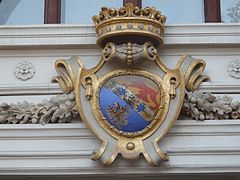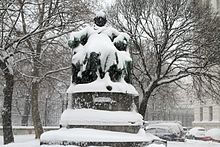Goethegasse
| Goethegasse | |
|---|---|
| Street in Vienna, Inner City | |
| Basic data | |
| place | Vienna, inner city |
| District | Inner City (1st District) |
| Created | 1862 |
| Newly designed | 1863 |
| Hist. Names | Albrechtsgasse |
| Cross streets | Hanuschgasse, Opernring |
| Buildings | Palais Schey von Koromla , Goethe Monument |
| use | |
| User groups | Pedestrian traffic , bicycle traffic , car traffic |
| Road design | one way street |
| Technical specifications | |
| Street length | approx. 170 meters |
The Goethegasse located on the 1st Viennese district , the Inner City . It was named in 1919 after the poet Johann Wolfgang von Goethe .
history
The Augustinian Bastion was located on the site of today's Goethegasse as part of Vienna's city fortifications . When the city wall with its bastions and the upstream glacis had long since ceased to fulfill a military function, it was decided to open Vienna's Ringstrasse as a splendid boulevard instead, and to erect new buildings and streets on both sides of it. One of the new streets was Albrechtsgasse , which opened in 1862 and initially only reached from today's Schillerplatz to Ringstrasse. In 1863 the Augustinerbastei opposite was demolished and Albrechtsgasse was subsequently extended on the inside of the city. This section formed the southern border of the castle garden . Albrechtsgasse was named after Field Marshal Archduke Albrecht .
In 1900 a monument to Johann Wolfgang von Goethe was erected at the confluence of the inner Albrechtsgasse with the Ringstrasse. This memorial was the reason that Albrechtsgasse was renamed Goethegasse after the end of the monarchy in 1919 . In 1978 the outer section of Goethegasse was separated from the Ringstrasse to Schillerplatz and it was named Robert-Stolz-Platz .
Location and characteristics
The Goethegasse runs from Hanuschgasse in a south-westerly direction to the side lane of the Opernring, with the Goethe monument being surrounded by the Goethegasse like an island. It is run as a one-way street . There is no public transport on it. Some of the sidewalks are extremely narrow, which means that pedestrians can usually get from the Albertina to the Ringstrasse via the adjacent castle garden . Since there are no shops or restaurants on Goethegasse, it is not particularly attractive for walkers. Reasons to come here are a police guard room and the federal theater administration.
The Burggarten park is located on the entire right-hand side of the street and is separated from the street by a magnificent fence . The brick castle garden gate allows access at the beginning of Goethegasse. The left side of the street, on the other hand, is built very uniformly in the historicist style of the neo-renaissance . At the beginning of Goethegasse there is a statue for the baroque poet Abraham a Sancta Clara , at the end of which is the Goethe monument by Edmund Hellmer . The park, the monuments and one of the two buildings are under monument protection .
Buildings
Abraham a Sancta Clara monument
At the beginning of Goethegasse, on the corner of Hanuschgasse and next to the Burggartentor, is the simple figure of the German Baroque preacher and poet Abraham a Sancta Clara, who was one of the most important Catholic preachers in Vienna. Hans Schwathe created this monument in 1928, which consists of a base with an inscription and a standing stone figure of the preacher in religious costume. It is a listed building.
No. 1: Hanuschhof
Originally there was a riding school and stable building at this point, which were connected to the Archduke Albrecht's palace by a covered walkway . The former outbuilding of the Archduke Albrecht-Palais was built between 1862 and 1863 by master builder Anton Ölzelt based on plans by architect Anton Hefft on the corner of Hanuschgasse. The name Hanuschhof, which is common today, is derived from its location on Hanuschgasse. One should not confuse the inner-city Hanuschhof with the municipal housing of the same name in Vienna's 3rd district, Landstrasse .
The Hanuschhof is a monumental building block on an irregular floor plan with three inner courtyards. Entrances are located on both Hanuschgasse and Goethegasse. The broad facade on Goethegasse is designed in the forms of the New Viennese Renaissance and structured by risalites set in stone blocks as well as gable windows arranged in rows. The main entrance on Goethegasse consists of a three-aisled pillar hall with a pendentive dome between barrel vaults. In the main courtyard there is a free-standing neo-baroque new building by Hugo Schuster from 1914 instead of an early historical winter riding school .
The spacious premises mainly house the offices and facilities of the Austrian federal theaters. ART for ART Theaterservice GmbH operates costume workshops here. From 2005 to 2014 the State Opera Museum was also located in the Hanuschhof.
Burggarten
→ see also main article Burggarten (Vienna)
The important park, which goes back to a medieval paradise garden, completes the Hofburg complex towards the southeast. It is a late classicist complex in the form of an English garden with old trees. In the castle garden there is a pond and several monuments; at the edges the park closes with terraces, open stairs and the palm house.
The Burggarten is separated from the Ringstrasse and Goethegasse by a fence built between 1863 and 1865 with an originally gilded grid. The design comes from Moritz von Loehr , the grilles were made by the Fürst Salmschen Eisengießerei in Blansko , whereby those on Goethegasse had to be renewed after 1945. The grids rest on a stone base between cast iron columns with lanterns.
The Burggartentor is located on the corner of Goethegasse and Hanuschgasse. It is a Tuscan portico with a bronze double-headed eagle above it. The wrought iron grille is also remarkable. Vases rise from the entablature that extends to the side . The Burggarten Gate was designed by Ludwig Baumann in 1910 .
No. 3: Palais Schey of Koromla
→ see also main article Palais Schey von Koromla
The historicist building in the form of the Italian Renaissance was built between 1862 and 1864 by Johann Romano vonringen and August Schwendenwein von Lanauberg on the corner of Goethegasse and Opernring for the banker Friedrich Schey von Koromla . The facade consists of a high rusticated base zone with arcades on the side facing the Opernring . The upper zone is square in stone and shows aedicule windows with Corinthian three-quarter columns on consoles , cornice and parapet balustrade on the piano nobile . The facade ends with a recessed parapet balustrade .
The mighty portal is remarkable. In front of pilasters , two-story Corinthian columns rise on high pedestals. In between there are niches with cups and mezzanine windows. Above the gate you can see a heraldic cartouche with a crown and a thermal bath window. The mighty, protruding entablature supports a bel étage balcony on a shell console.
The vestibule , inner courtyard and stairwell as well as a former study in the mezzanine are richly furnished . The interior decoration is designed in the neo-rococo style. The building is a historical monument.
Goethe monument
→ see also main article Goethedenkmal (Vienna)
At the confluence of Goethegasse with Opernring, in the middle of the roadway, stands the monument to Johann Wolfgang von Goethe. It is directly opposite the older Schiller monument on Schillerplatz. It was created by Edmund von Hellmer from 1895 to 1900 and unveiled in 1900.
The monument consists of a spacious, stepped base and pedestal on which the bronze figure of the poet rests in a grand armchair. An inscription plate on the base reminds of the establishment by the Vienna Goethe Association. The monument is a listed building.
literature
- Richard Perger: streets, towers and bastions. The road network of the Vienna City in its development and its name. Franz Deuticke, Vienna 1991, ISBN 3-7005-4628-9 , p. 53.
- Felix Czeike (Ed.): Goethegasse. In: Historisches Lexikon Wien . Volume 2, Kremayr & Scheriau, Vienna 1993, ISBN 3-218-00544-2 , p. 563 ( digitized version ).
- Bundesdenkmalamt (Ed.): Dehio-Handbuch Wien. I. District - Inner City. Berger, Horn 2003, ISBN 3-85028-366-6 , pp. 698-699.
Web links
Coordinates: 48 ° 12 ′ 14.1 ″ N , 16 ° 22 ′ 0.9 ″ E















